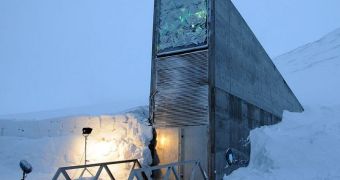The Svalbard "Doomsday" Global Seed Vault is a facility located on the Norwegian island of the same name, which has been constructed specifically to promote plant diversity. Its creators say that the large underground facility is meant to safeguard as many plant species as possible in face of natural and man-made disasters, such as global warming. The people behind the project say that many reckless people are currently given too much power, and that they use it to either do bad things, or simply nothing at all, even when presented with the solid case that is the body of work arguing for climate change.
Action in this particular field is stifled by many factors, including the sheer ignorance some exhibit, the lack of political will, the financial interests of oil companies, and so on. Therefore, it's the purpose of the Vault to safeguard these valuable plant seeds, whose number has now reached 500,000. This is a momentous achievement, given that the structure itself was only officially opened on February 26, 2008. Some of the latest additions before the mark was reached include a mold-resistant bean, a German pink tomato, as well as a wild strawberry, LiveScience reports.
“Reaching the half million mark brings mixed emotions, because while it shows that the vault at Svalbard is now the gold standard for diversity, it comes at a time when our agriculture systems are really sitting on a knife's edge. If crops and agriculture don't adapt to climate change, neither will humanity,” explains the executive director of the Global Crop Diversity Trust, Cary Fowler. The company works together with the Norwegian government and the Nordic Genetic Resource Center, in Sweden, for constructing and operating the vault.
And the structure indeed looks as if it were protected from Doomsday. It is buried deep within the permafrost, and additional cooling keeps the temperatures to around minus 0.4 degrees Fahrenheit (minus 18 degrees Celsius) at all times. “The region on Svalbard surrounding the Seed Vault is remote, severe, and inhabited by polar bears. Anyone seeking access to the seeds themselves will have to pass through four locked doors: the heavy steel entrance doors, a second door approximately 115 meters down the tunnel and finally the two keyed air-locked doors. Keys are coded to allow access to different levels of the facility. Not all keys unlock all doors,” members of the Trust write.
“Svalbard is a fail-safe backup to be used whenever a depositing seed bank loses part or all of its collection, but we should focus equally on averting the disasters in the first place,” Fowler adds. “We're seeing in several of the soybean varieties intriguing traits that could allow farmers to confront such problems as drought or extreme heat, shorter or longer growing seasons, or higher levels of CO2 [carbon dioxide],” explains the curator of the US Department of Agriculture (USDA) National Center for Genetic Resources Preservation, Dave Ellis.

 14 DAY TRIAL //
14 DAY TRIAL //